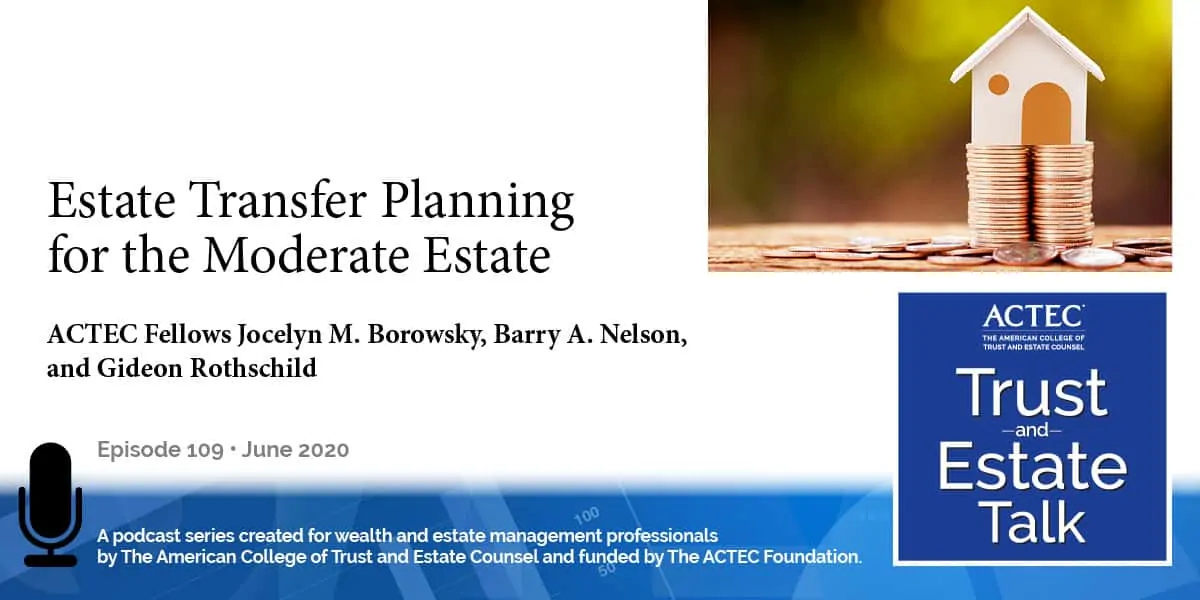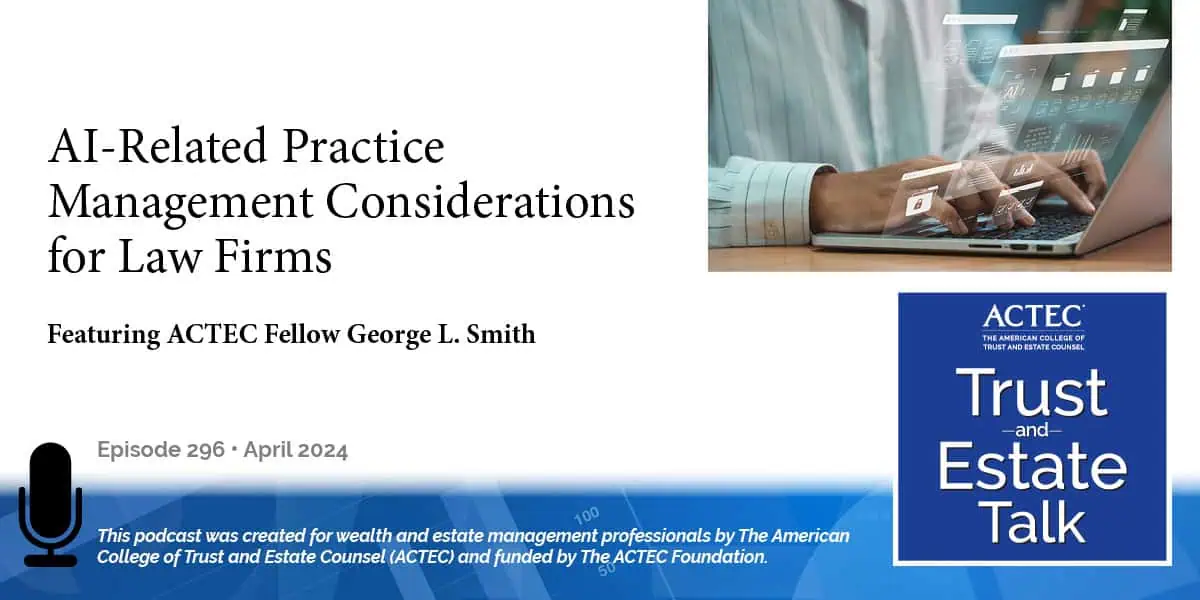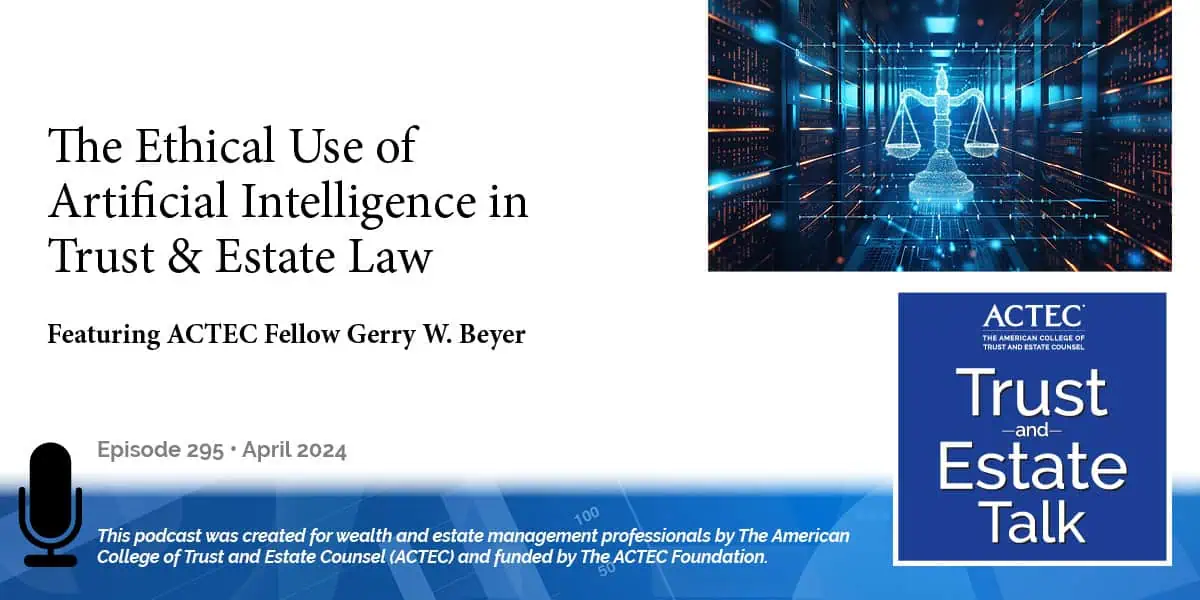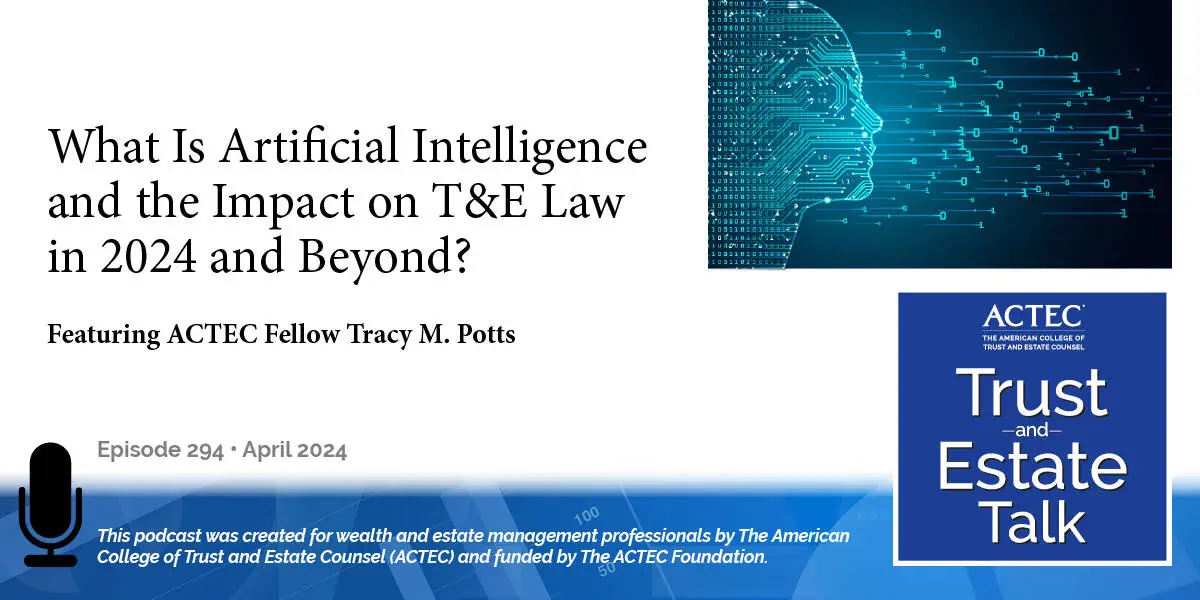Estate Transfer Planning for the Moderate Estate

“Having Your Cake and Eating it Too, Transfer Planning for the Moderate Estate,” that is the subject of today’s ACTEC Trust & Estate Talk.
Transcript/Show Notes
This is Stacy Singer, ACTEC Fellow from Chicago. With higher estate tax exemptions available, how can our high, but not ultra high-net-worth, clients hedge their risk by gifting assets to trust while remaining assured they can access those assets in the future? To give us more information on this topic, you will be hearing today from ACTEC Fellows Jocelyn Borowsky of Wilmington, Delaware; Barry Nelson of Aventura, Florida; and Gideon Rothschild of New York City. Welcome Jocelyn, Barry and Gideon.
Thank you. So, today we are going to talk about what our clients should be doing when we know that there is a strong possibility that, at least in 2026, the exemption, the basic exclusion amount, will be reduced from the current $11.58 million possibly to about half of that. One of the things that I did when I tried to get my clients to consider what to do is to give them a little questionnaire. And I gave them a number of questions to consider. And these are the questions, and many of them have taken no action, but these are the considerations that they should make possibly before January 1st, 2021. And the reason for that is it is possible that if there is new legislation, it could be effective January 1st, 2021; and the only likelihood of that legislation is if there is a new president and a new Congress that think the same way.
Estate Transfer Questions for Consideration
So here are the questions. To save future transfer taxes, would you be willing to make a 2020 gift of up to $11.58 million if you are single, $23.16 million jointly, reduced by any prior gifts that you made if those gifts that you can make tax-free will not be benefiting you or your spouse after you make those? So, the clients who are interested in doing that are the high-net-worth clients. Most clients cannot afford to do that.
The second question—to save future taxes, would you make 2020 gifts of up to an $11.58 million single, reduced by any prior gifts, into a trust for your spouse, where your spouse and your children may receive distributions at the discretion of the trustee? Upon the death of your spouse, the trust assets will be held exclusively for your children. So, those assets will not go back to you, the donor.
Three—to save future transfer taxes, would you make 2020 gifts of up to $11.58 million, reduced by prior taxable gifts, into a trust for your spouse and possibly your children in 2020 where your spouse and your children may receive distributions at the discretion of the trustee? Upon your spouse’s death, your spouse can decide on whether any portion of the trust assets will revert into a new trust created by your spouse for your benefit; and in such event, an independent trustee will determine the extent that you receive assets back. That sounds good to a lot of people, and the trust is typically called a SLAT (Spousal Lifetime Access Trust). The problem is that there is a question as to whether if your spouse exercises the power to give the assets back upon her death to the original settlor, whether those assets will be includable in the original settlor’s estate, based upon the relation-back doctrine, which is a subject for another podcast. But there is a risk in doing that. The use of this question of proceeding by giving the spouse the right is effective because there is a possibility the original donor can get the property back, but there is not a requirement; and the mere giving the spouse the ability to do that is not going to create estate tax inclusion.
The next one is to save the future estate taxes – would you create such a trust in an asset protection trust jurisdiction like Alaska? Delaware? In using that technique, many people think that is an effective way to handle it because there is a Private Letter Ruling 200944002 that says you can make such a gift. I am going to now turn this over to Jocelyn, and she is going to talk about some of the drawbacks of some of these options.
Domestic Asset Protection Trust (DAPT)
Okay. Thank you. I am going to pick up where Barry just left off with respect to a gift into a self-settled trust. I am going to call it a completed gift to a DAPT, standing for Domestic Asset Protection Trust. So, the idea behind this plan is that your client is going to want to use up the client’s applicable exclusion amount before it expires, make a completed gift, have the assets and any appreciation thereon excluded from the client’s gross estate at death, but also retain some access to the fund. And the reason the settlor can retain some access to the fund is because by definition, an asset protection trust is really a self-settled trust.
So, that is the plan and the benefit and the purpose, but there are some potential risks associated with this plan and also some detriments. The first one is that—and I always tell this to my clients—the settlor of this self-settled trust should only take distributions in case of an emergency, and I will explain why. And, you also have to use an asset protection trust in a state that has DAPT legislation, and there are now 19 of those states. So, the first question you might have is why do you have to use an asset protection trust to begin within a DAPT jurisdiction? Well, this just goes back to the settled law that if you settle a self-settled trust in a state that does not have that DAPT legislation, under principles of common law, creditors of the settlor can get access to the trust assets. And, you can see that in UTC Section 505 or the Restatement (Third) of Trust Section 58; and we know that if the settlor’s creditors can get access to the trust, it is not a completed gift under Code Section 2511. It would be a retained interest in the settlor’s estate at death under 2038 or 2036.
So, you might wonder why it is that it is not automatically incomplete gift or included in the settlor’s gross estate at death because, after all, this is a device where the settlor has retained an interest. And, the authority for this type of plan really derives from a series of letter rulings and revenue rulings. The most important of which are Revenue Ruling 2004-64 and Private Letter Ruling 200944002. So, I am going to just talk about the Revenue Ruling because we know that letter rulings are not precedent and cannot be cited for precedent.
Risks Regarding Revenue Ruling 2004-64
The Revenue Ruling did not involve a self-settled trust. It was a third-party trust, but there was a tax reimbursement clause, and there are three different situations posited in the Revenue Ruling; but focusing on the one where the trustee had authority, it was not mandatory but it was authorized to reimburse the settlor for taxes attributable to the trust income because of the grantor trust. And, the service concludes in that Revenue Ruling that merely because the funds could be used for the settlor’s benefit, that would not automatically create an estate tax upon death. But if there were other facts present, those other facts coupled with the permissible interest would possibly cause estate inclusion. And those three other facts were number one—if the settlor had the power of the trustee, either because the settlor was named as trustee directly or had the power to remove and replace the trustee, not limited to someone who is not related or subordinate. So, that is one bad fact. Second bad fact would be if there were an implied agreement between the trustee and the settlor to make distributions back to the settlor, or number three, if the settlor’s creditors could access the trust under state law.
So, anyway, in a nutshell, there are some risks around those three bad facts, and I am going to turn it over to Gideon who has lots to say about other planning with access.
DAPT or SLAT
Thank you, Jocelyn. So, I break the clients that we need to address here into two categories: one married and those that are not married. Those that are not married are likely going to use the DAPT concept more than anything else versus those who were married might prefer—instead of a self-settled trust and taking the risks that Jocelyn referred to—to do a spousal trust. Something Barry referred to in his earlier questions, otherwise known as a SLAT to some people – a Spousal Lifetime Access Trust – because by doing so, the trustee can make distributions to the settlor’s spouse and thereby enable the settlor to receive the benefits from that trust if needed. But then the problem comes up often, or the question comes up, well, what if we get divorced? What if my spouse, my donee spouse, dies before me? How do I continue to have access to that trust? There are a number of variations that we could build into a trust. For example, we could provide that in the event there is a death of the donee spouse prior to the settlor’s spouse, then the settlor becomes a discretion beneficiary of the trust, thus, making it a DAPT. And you would want to make sure that that trust is then governed by the laws of one of the 19 DAPT states or a foreign jurisdiction that Jocelyn had alluded to earlier.
Another possibility is by allowing the spouse to have—the donee spouse—to have a power of appointment to appoint the assets of the trust back in favor of the donor spouse. Barry alluded to that concept and there are a number of states—about a dozen states—that have statutorily provided that when that settlor’s spouse becomes a beneficiary at a later date as a result of an exercise of the power of appointment, that settlor is not considered the settlor for creditor purposes. And therefore, it is not considered a DAPT at that point, as long as you are settling the trust in one of those dozen or so states.
And the third possibility is something referred to as a SPAT – we love these acronyms, of course, as trusts and estates lawyers—GRATs and GRITs and SPATs and SLATs. And the SPAT is a Special Power of Appointment Trust, something that our esteemed colleague Jonathan Blattmachr wrote about a year ago in the, I think it was the February 2019 estate planning issue. And the SPAT is basically giving a third-party, and it could even be a beneficiary—depending on whether you wanted to be a grantor trust or a non-grantor trust—a third-party the power to actually direct the trustee to make a distribution to someone who is not designated as a beneficiary of the trust instrument. And it could be someone defined in the class of those descendants of the settlor’s parents, which would obviously include the settlor and thereby, if the unexpected occurs, either through a divorce or the donee’s spouse dying first and the settlor has financial reversals and needs access to the trust, that third-party can exercise that power and direct the trustee to make a distribution. More to come. Thank you.
Thank you all so much for educating us on planning for the non-transfer-taxable estate.
This podcast was produced by The American College of Trust and Estate Counsel, ACTEC. Listeners, including professionals, should under no circumstances rely upon this information as a substitute for their own research or for obtaining specific legal or tax advice from their own counsel. The material in this podcast is for information purposes only and is not intended to and should not be treated as legal advice or tax advice. The views expressed are those of speakers as of the date noted and not necessarily those of ACTEC or any speaker’s employer or firm. The information, opinions, and recommendations presented in this Podcast are for general information only and any reliance on the information provided in this Podcast is done at your own risk. The entire contents and design of this Podcast, are the property of ACTEC, or used by ACTEC with permission, and are protected under U.S. and international copyright and trademark laws. Except as otherwise provided herein, users of this Podcast may save and use information contained in the Podcast only for personal or other non-commercial, educational purposes. No other use, including, without limitation, reproduction, retransmission or editing, of this Podcast may be made without the prior written permission of The American College of Trust and Estate Counsel.
If you have ideas for a future ACTEC Trust & Estate Talk topic, please contact us at ACTECpodcast@ACTEC.org.
© 2018 – 2024 The American College of Trust and Estate Counsel. All rights reserved.
Latest ACTEC Trust and Estate Talk Podcasts

AI-Related Practice Management Considerations for Law Firms
A discussion for law firms about how to incorporate AI in their practice management, including staff considerations, the “billable hour,” and more.

The Ethical Use of Artificial Intelligence in Trust & Estate Law
A law professor offers insights into the risks, rewards, duties and ethical considerations of lawyers using AI in their T&E practices.

What Is Artificial Intelligence and the Impact on T&E Law in 2024 and Beyond?
A primer on the types and uses of AI, then a deeper dive into the impact on trust and estate law from types to applications to ethical considerations.

